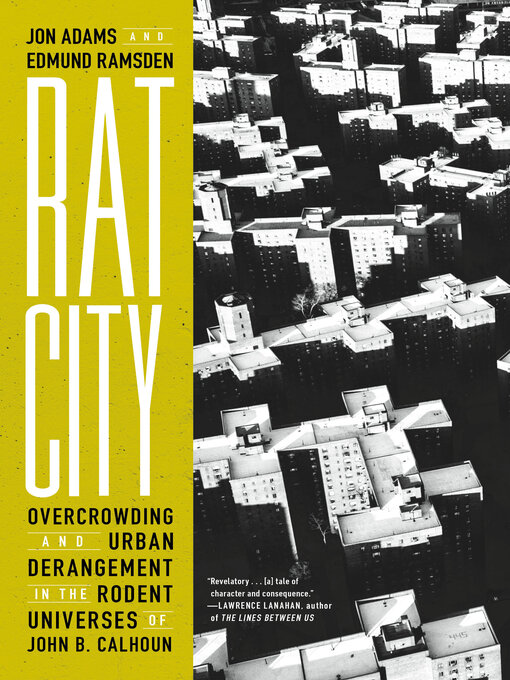Rat City
Overcrowding and Urban Derangement in the Rodent Universes of John B. Calhoun
A New York Times Editors' Choice
"Entertaining, phenomenally weird . . . Rat City may well be the world’s first-ever work of socio-biographical-scientific pop history. . . .a freaky romp down a peculiar passage in the history of ideas, full of oddball cameos (Aldous Huxley! Buckminster Fuller!) and some very sharp science writing."—The New York Times
"Facebook, Yik Yak, Twitter, Twitch—each had a sunny, expansive phase, followed by a descent into flaming, catfishing, and troll wars. To the extent that Calhoun’s rats have any sociological relevance, it would seem to be in the mirror world of the Web. What, after all, could be a better description of X these days than a “behavioral sink”?" —The New Yorker
Behind the internet's viral "Universe 25" experiment and Robert C. O'Brien's iconic novel, Mrs. Frisby and the Secret of NIMH, was one scientist who set out to change the way we view our fellow man — using rats . . .
After the Civil War and throughout the twentieth century, cities in northern American states absorbed a huge increase in populations, particularly of immigrants and African Americans from southern states. City governments responded by creating new regulations that were often segregationist — corralling black Americans, for example, into small, increasingly overcrowded neighborhoods, or into high-rise “projects.”
The situation intensified after World War II, as rising crime and racial unrest swept the nation, and blame fell on the crowded conditions of city life. The hardest-hit populations were left marginalized and voiceless.
Enter John B. Calhoun, an ecologist employed by the National Institute of Mental Health to study the effects of overcrowding on rats. From 1947 to 1977, Calhoun built a series of sprawling habitats in which a rat’s every need was met—except space. The results were cataclysmic. Did a similar fate await our own teeming cities?
Rat City is the first book to tell the story of Calhoun’s experiments, and their extraordinary influence — an enthralling record of urban design and dystopian science. Meticulously researched, it follows Calhoun’s struggle to solve the problem of crowding before America’s cities drain into the behavioral sink. And as the “war on rats” continues around the world, and our post-pandemic society reevaluates the necessity of urban living, the riveting story of Rat City is more relevant than ever.
-
Creators
-
Publisher
-
Release date
July 16, 2024 -
Formats
-
Kindle Book
-
OverDrive Read
- ISBN: 9781685891008
-
EPUB ebook
- ISBN: 9781685891008
- File size: 8632 KB
-
-
Languages
- English
-
Reviews
-
Kirkus
June 1, 2024
A consideration of an ecologist who spent three decades studying rats as a method for understanding how humans might react as urban density grew. From 1947 to 1977, John B. Calhoun, employed by the National Institute of Mental Health to study the consequences of overcrowding, built large-scale rat habitats designed to allow his subjects to display their innate social behaviors. Over time, deprived of space to expand as the population grew, the rodents' "escalating social disorder collapsed to violent extinction." Overcrowded conditions led to infant neglect, lower fertility rates, aggressive sexual activity, and rampant violence. Interestingly, rats who opted for social withdrawal as a survival technique were calm and healthy. Adams, a former BBC New Generation Thinker, and Ramsden, a historian of science at Queen Mary University of London, offer detailed histories of urban development, in cities like Baltimore and New York, showing how rat infestations have always accompanied human population growth. They explain when and how rats were used as models for psychological and behavioral research, as well as conclusions from various approaches to eradicating rats--i.e., poisoning is only a temporary solution. "Rats had lived in American cities as long as people had: either both belonged there, or neither did," write the authors. When Calhoun built his first citylike habitat (the Towson enclosure) in the 1950s, he documented every detail. His 1963 book, The Ecology and Sociology of the Norway Rat (the result of two years of daily observations, followed by six years of analyzing and writing his discoveries) "was, and remains, the most comprehensive and complete account of rodent behavior ever produced." The authors also explore biographical details, from Calhoun's background and personal life to the evolution of his interests. More academic and less entertaining than Robert Sullivan's Rats, this book is nonetheless comprehensive. A largely fascinating book combining sociology, nature, and urban studies.COPYRIGHT(2024) Kirkus Reviews, ALL RIGHTS RESERVED.
-
Formats
- Kindle Book
- OverDrive Read
- EPUB ebook
subjects
Languages
- English
Loading
Why is availability limited?
×Availability can change throughout the month based on the library's budget. You can still place a hold on the title, and your hold will be automatically filled as soon as the title is available again.
The Kindle Book format for this title is not supported on:
×Read-along ebook
×The OverDrive Read format of this ebook has professional narration that plays while you read in your browser. Learn more here.

